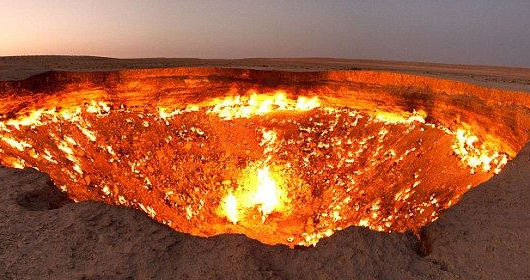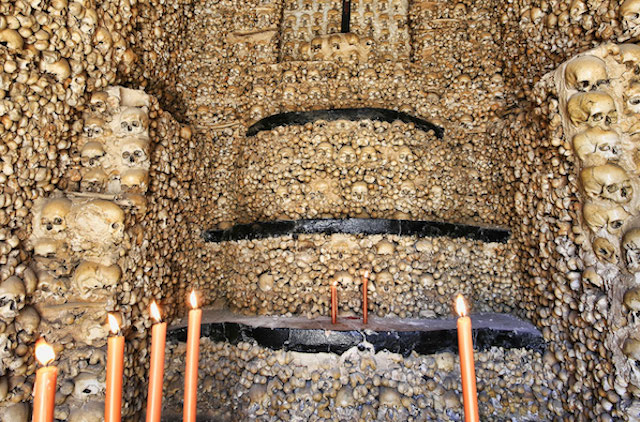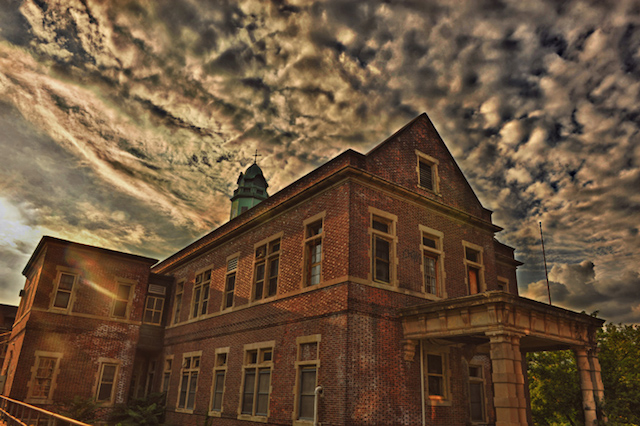(单词翻译:单击)
7.Derweze, Turkmenistan
7.土库曼斯坦,达瓦扎
Turkmenistan is a country in Central Asia that borders Afghanistan. Within the country, there is a town called Derweze, which is in the Karakum (Black Sands) Desert. And not far from the town is a fiery crater that the locals have dubbed "The Door to Hell."
土库曼斯坦是一个中亚国家,与阿富汗接壤。在这个国家有一座小镇叫达瓦扎,位于卡拉库姆沙漠(黑沙漠)。距离小镇的不远处有一个炽热的火坑,当地人称之为"地狱之门"。
The crater is 225 feet wide and 99 feet deep and while it does quite literally look like the entrance to hell, it's actually a natural gas fire.
火坑直径225英尺,深99英尺。虽然它看起来很像地狱的入口,实际上却是一个天然气火口。

In 1971, there was some drilling going on in the area and the equipment hit a cavern and fell in. Luckily no one was hurt, but scientists were worried that the gas would be poisonous.
1971年,地质学家在此地勘探,用设备钻出一个洞穴后地面出现塌陷。所幸没有人受伤,但是科学家们担心这些气体有毒。
So in an incredible miscalculation, scientists suggested starting a fire, thinking it would burn off in a few days.
因而做出了令人难以置信的错误判断,他们点燃了这些气体,以为它会在几天内燃烧掉。
It was afterwards that they found out that Turkmenistan has the fourth largest natural gas reserve in the world and the fire still burns today. The country is hoping to turn the area into a tourist attraction.
后来他们才发现,土库曼斯坦拥有世界上第四大天然气储量,而大火至今还在燃烧。因此,国家希望把该地区变成一个旅游景点。
6.Capela dos Ossos, Evora, Portugal
6.葡萄牙,埃武拉市,人骨礼拜堂
Capela dos Ossos, or "Chapel of Bones" is the most popular tourist attraction in the medieval Portuguese city of Evora.
人骨礼拜堂,是葡萄牙中世纪古城埃武拉市最受游客欢迎的景点。
The big draw of the 16th century chapel is a room that was constructed from the bones of 5,000 monks.
这座礼拜堂始建于16世纪,由5000名僧侣的尸骨搭建而成。
Then just to make it even creepier, there is also the body of a woman and a child hanging from a wall, but no one is really sure why their bodies are there.
更令人毛骨悚然的是,还有一面墙上吊着一具妇女和一具男婴的骷髅,但是没人能说清她们的遗骸为何会挂在那里。

The reason the monks bones' were used was because at the time it was constructed in the 16th century, Evora was running out of room to bury people.
在16世纪搭建这座礼拜堂的时候,埃武拉正面临墓地紧缺的困境,因此才使用了僧侣的尸骨。
There were already 43 cemeteries and the city was going to get rid of a few. In order to save the souls of monks that died, 5,000 of their bodies were exhumed.
当时已有43座墓园,而埃武拉准备撤掉几座。为了保护去世僧侣的灵魂,他们的5000具遗骸被挖了出来。
With the remains, the church decided to use them as a message to the wealthy citizens of Evora. They constructed the room using the bones to remind people that once you were dead, you couldn't take your riches with you.
教堂决定用这些遗骸给埃武拉的富裕市民以启示。他们用尸骨搭成这座礼拜堂,以此提醒人们,财富并不能在死后一起带走。
Hence the message at the entrance, "We bones that are here, for your bones we wait."
所以入口才会写着:"我们的尸骨在此等待你们的尸骨。"
5.Hashima Island, Japan
5.日本,端岛
Hashima Island sits about nine miles off the coast of Nagasaki in Southern Japan.
端岛坐落于日本南部的长崎市外约9英里处。
In the 1880s, coal was found on the sea floor of the island, and originally, workers were ferried to and from the island. Then the mining company thought it would just be easier to build places for the workers to live.
19世纪80年代,人们在这座岛屿的海底发现了煤。起初,采煤工人们坐船往返于这座岛。后来矿业公司认为,让工人们住在岛上会更方便。

On about 67,000 square feet, which is a little bit larger than a football field, the company created a community complete with restaurants, bathhouses, apartments and even a graveyard.
于是公司建了一个67000平方英尺的社区(比足球场稍大一点),里面餐馆、澡堂、公寓应有尽有,甚至还有一个墓地。
In 1959, 5,259 people were living on the island, making it the most densely populated place on Earth ever.
1959年,岛上有5259名居民,是当时地球上人口密度最大的地方。
In 1974, the coal was all mined and the mining company made an announcement that there would be work on the mainland, but it would be on a first come, first serve basis.
1974年煤矿开采完后,矿业公司宣布内地有工作,但是要根据先来后到的原则招工。
This caused many people to pick up and leave quickly, leaving behind a lot of personal items like tea cups on tables and bikes leaning up against walls, which gives the island a very post-apocalyptic feel.
很多人因此匆匆打包离开,留下了许多个人物品,比如桌上的茶杯、墙角的自行车等,使这个岛屿带上了一种"后启示录"的末日感。
4.Pennhurst State School and Hospital, Pennsylvania
4.宾夕法尼亚州,潘赫斯特州立学校和医院
The Eastern Pennsylvania State Institution for the Feeble-Minded and Epileptic opened in 1908 in East Vincent, Pennsylvania. Shortly after opening, the institution was grossly misused.
1908年,专门为智能低下以及癫邪症患者所开设的东宾夕法尼亚州立机构在滨州东文森特成立。这间机构开设后不久就违背了它原本的初衷。
Instead of only taking in people with disabilities, it also housed criminals, immigrants and anyone else who had no place to go, making it overcrowded within months of opening its doors.
非但没有招收残疾人,反而开始收容罪犯、移民者以及那些无家可归的人,导致这里在刚开始的几个月就变得十分拥挤。
By the 1960s, the name had been changed to the Pennhurst State School and Hospital and there were over 2,700 residents, mostly children. The problem was that conditions, like many other state intuitions at the time, were horrible.
20世纪60年代,它正式改名为潘赫斯特州立学校和医院,容纳了2700多人,其中大部分都是孩子。很快,这里也和其他许多州立机构一样,出现了很多严重的问题。

The staff was minimal and a vast majority of the children were not properly helped. Some doctors were also a bit sadistic.
员工少,大部分孩子得不到有效救助。有些医生还有虐待癖。
For example, in a news expose from the mid-1960s, a doctor talked about what he did with one patient he described as "a bully."
例如,新闻曾曝光过,在20世纪60年代中期,有一位医生坦白了他对一个"横行霸道"的病人所做的一切。
The doctor said he discussed with his colleagues, what he could inject into the patient that would cause the most pain but wouldn't leave permanent damage.
那个医生曾和同事一起讨论要给病人注射一种药剂,这种药剂可以让病人痛不欲生,但是却不会对病人造成永久性的伤害。
After the discussion, he pulled the patient aside and used the substance to chemically torture him.
讨论完,他就把这个病人拉到一边,给他注射了这种用来折磨他的药剂。
The expose brought the conditions of the hospital to light, which signaled the end and by 1987, the school was closed and abandoned.
这段新闻将医院的一些情况公之于众,也预示着这家医院的终结。1987年,学校也关门了。
Today it is privately owned and the owners run a haunted house attraction that has drawn criticism because some people feel it's exploitative.
如今的这个地方属于私人所有,所有者将其经营成一座鬼屋景点,受到了公众的指责,因为很多人都觉得这个地方像是个剥削工厂。


